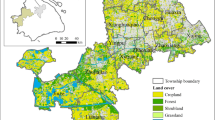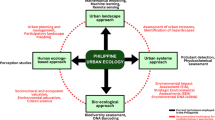Abstract
Ecological sensitivity is defined as the ecosystem’s reaction to environmental change caused by internal and external factors. The degree of ecological sensitivity varies in spatial dimension depending on the natural and cultural features. Ecological sensitivity analysis is based on basis of mapping these differences. As a result of the analysis, an important data that can be a base for spatial plans at different scales is provided. In accordance with this aim, Denizli province was selected for the study area in this research. The factors affecting sensitivity were determined by the literature survey, which was conducted by considering the characteristics of the study area. In this context, elevation, slope, aspect, the proximity to water surface, land cover, and vegetation coverage were evaluated as natural factors, and the proximity to primary traffic roads and residential areas as cultural factors. Each factor was spatially grouped by means of geographic information systems (GIS) according to the degree of impact on ecological sensitivity. Scale 1 (lowest ecological sensitivity) to 5 (highest ecological sensitivity) was used for the spatial grouping. A analytical hierarchy process (AHP) was applied to weight the factors. The overlay method was used in line with the weighted scores in order to determine the composite ecological sensitivity. As a result of the study, the area of 286.26 sq km (2.37%) as highly and more sensitive, 5267.47 sq km (43.50%) as moderately sensitive, and 6554.56 sq km (54.13%) as mildly and less sensitive was determined. In line with the results, suggestions for protection-utilization balance were developed.





Similar content being viewed by others
References
Altan, T. (1982). A research on ecological landscape planning application at regional scale with the help of computer in Çukurova and determination of land use suggestion. Çukurova University Faculty of Agriculture Publications no:161/52, Adana, 87 pgs.
Carlson, T. N., & Ripley, D. A. (1997). On the relation between NDVI, fractional vegetation cover, and leaf area index. Remote Sensing of Environment, 62(3), 241–252.
CLC - Corine Land Cover. (2019). https://land.copernicus.eu/pan-european/corine-land-cover
Dobbs, C., Hernández-Moreno, Á., Reyes-Paecke, S., & Miranda, M. D. (2018). Exploring temporal dynamics of urban ecosystem services in Latin America:The case of Bogota (Colombia) and Santiago (Chile). Ecological Indicators, 85(2018), 1068–1080.
Doğan D., & Şahin Ş. (2018). Ecological connectivity: Example of Denizli Province. In: Current academic studies in architectural sciences-2018, Gece Kitaplığı, 291-303.
Düzgüneş, E., & Demirel, Ö. (2016). Revealing the protection structure of National Parks through ecological sensitivity analysis: Example of Altındere Valley National Park (Trabzon/Turkey), Kastamonu Univ., Journal of Forestry Faculty, 16(1).
Ersayin, K., & Tagil, S. (2017). Ecological sensitivity and risk assessment in the Kizilirmak Delta. Fresenius Environmental Bulletin, 26, 6508–6516.
Governorate of Denizli. (2020). http://www.pamukkale.gov.tr/
Hak, J. C., & Comer, P. J. (2017). Modelling landscape condition for biodiversity assessment – Application in temperate North America. Ecological Indicators, 82(2017), 206–2016.
Huang, S., & Nan, L. (2017). Urban ecological sensitivity evaluation of Anshun, China. International Journal of Environmental Science and Development, 8(9), 630–634.
MEU - Ministry of Environment and Urbanization. (2019). https://mpgm.csb.gov.tr/aydin%2D%2D-mugla%2D%2D-denizli-planlama-bolgesi-i-82184
Mingwu, Z., Haijiang, J., Desuo, C., & Chunbo, J. (2010). The comparative study on the ecological sensitivity analysis in Huixian karst wetland, China. Procedia Environmental Sciences, 2, 386–398.
Mücher, C. A., Bunce, R. G. H., Jongman, R. H. G., Klijn, J. A., Koomen, A. J. M., Metzger, M. J., & Wascher, D. M. (2003). Identification and characterisation of environments and landscapes in Europe. In Alterra rapport 832. Alterra: Wageningen.
Nilsson, C., & Grelsson, G. (1995). The Fragility of Ecosystems: A Review. The Journal of Applied Ecology, 32(4), 677.
OSM - Open Street Map. (2019). http://download.geofabrik.de/
Ozyavuz, M., Karakaya, A. B., & Ertin, D. C. (2018). Analysis of bioclimatic comfort of Tekirdağ (Turkey) province with geographical information systems. Journal of Environmental Protection and Ecology, 19(1), 407–416.
Özhancı, E., & Yılmaz, H. (2018). Sensitivity analysis in landscape ecological planning; the sample of Bayburt. Journal of Agricultural Faculty of Bursa Uludag University., 32(2), 77–98.
Pan, D., Jia, H., & Yuan, Y. (2015). A GIS-based ecological safety assessment of Wushen banner, China. Human and Ecological Risk Assessment: An International Journal, 21(2), 297–306.
Pan, F., Tian, C., Shao, F., Zhou, W., & Chen, F. (2012). Evaluation of ecological sensitivity in Karamay, Xinjiang, China. Journal of Geographical Sciences, 22(2), 329–345.
Saaty, T. L. (1983). Priority setting in complex problems. IEEE Transactions on Engineering Management, 3, 140–155.
Saaty, T. L. (1990). How to make a decision: The analytic hierarchy process. European Journal of Operational Research, 48(1), 9–26.
Sobrino, J. A., Jiménez-Muñoz, J. C., & Paolini, L. (2004). Land surface temperature retrieval from LANDSAT TM 5. Remote Sensing of Environment, 90(4), 434–440.
Sternberg, M., & Shoshany, M. (2001). Influence of slope aspect on Mediterranean woody formations: Comparison of a semiarid and an arid site in Israel. Ecological Research, 16(2), 335–345.
Sun, X., Crittenden, J. C., Li, F., Lu, Z., & Dou, X. (2018). Urban expansion simulation and spatio-temporal changes of ecosystem services, a case study in Atlanta metropolitan area, USA. Science of the Total Environment, 622-623(2018), 947–987.
Toy, S., Yilmaz, S., & Yilmaz, H. (2007). Determination of bioclimatic comfort in three different land uses in the city of Erzurum, Turkey. Building and Environment, 42(3), 1315–1318.
Tsou, J., Gao, Y., Zhang, Y., Genyun, S., Ren, J., & Li, Y. (2017). Evaluating urban land carrying capacity based on the ecological sensitivity analysis: A case study in Hangzhou, China. Remote Sensing, 9(6), 529.
TUBIVES - Turkish Plants Data Service. (2020). http://www.tubives.com/
TSI - Turkish Statistical Institute. (2019). http://www.tuik.gov.tr/Start.do
USGS - U.S. Geological Survey. (2019). https://earthexplorer.usgs.gov/
Wang, J., Zhou, W., Pickett, S. T. A., Yu, W., & Li, W. (2019). A multiscale analysis of urbanization effects on ecosystem services supply in an urban megaregion. Science of the Total Environment, 662(2019), 824–833.
Wu, H., Ye, L. P., Shi, W. Z., & Clarke, K. C. (2014). Assessing the effects of land use spatial structure on urban heat islands using HJ-1B remote sensing imagery in Wuhan, China. International Journal of Applied Earth Observation and Geoinformation, 32, 67–78.
Yang, H., Wenbo, C., & Chen, X. (2017). Regional ecological network planning for biodiversity conservation: A case study of China’s Poyang Lake eco-economic region. Polish Journal of Environmental Studies, 26(4), 1825–1833.
Yilmaz, S., Irmak, M. A., & Matzarakis, A. (2013). The importance of thermal comfort in different elevation for city planning. Global NEST Journal, 15(3), 408–420.
Yue, W. Z., Yao, H. N., & Zheng, J. E. (2013). Research on land population supporting capacity based on ecolgical sensitivity-Taking Hang Zhou city as an example. Nat Res Econ China, 15, 52–56.
Zengin, M. (2017). An overview of some landscape values of Denizli City. Perspectives 2017 Denizli File. Edition of Pamukkale University, e ISBN: 978-975-6992-70-8, s.13-22, Denizli.
Author information
Authors and Affiliations
Corresponding author
Additional information
Publisher’s note
Springer Nature remains neutral with regard to jurisdictional claims in published maps and institutional affiliations.
Rights and permissions
About this article
Cite this article
Yilmaz, F.C., Zengin, M. & Tekin Cure, C. Determination of ecologically sensitive areas in Denizli province using geographic information systems (GIS) and analytical hierarchy process (AHP). Environ Monit Assess 192, 589 (2020). https://doi.org/10.1007/s10661-020-08514-9
Received:
Accepted:
Published:
DOI: https://doi.org/10.1007/s10661-020-08514-9




